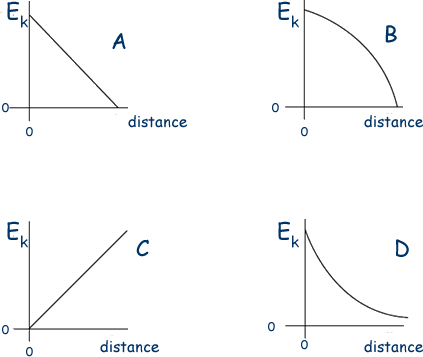Simple Harmonic Motion - Multiple Choice Questions Q1. A mass M hangs in equilibrium on a spring. M is made to oscillate about the equilibrium position by pulling it down 10 cm and releasing it. The time for M to travel back to the equilibrium position for the first time is 0.50 s. Which line, A to D, is correct for these oscillations? Q2. A particle oscillates with undamped simple harmonic motion. Which one of the following statements about the acceleration of the oscillating particle is true?
Q3. Which one of the following statements is true when an object performs simple harmonic motion about a central point O?
Q4. A particle of mass m executes simple harmonic motion in a straight line with amplitude A and frequency f. Which one of the following expressions represents the total energy of the particle? Q5. A body moves with simple harmonic motion of amplitude A and frequency b/2 What is the magnitude of the acceleration when the body is at maximum displacement? Q6. A simple pendulum and a mass-spring system are taken to the Moon, where the gravitational field strength is less than on Earth. Which line, A to D, correctly describes the change, if any, in the period when compared with its value on Earth?
Q7. A simple pendulum and a mass-spring system both have the same time period T at the surface of the Earth. If taken to another planet where the acceleration due to gravity was half that on Earth, which line, A-D, in the table gives correctly the new periods? Q8. Which one of the following statements is not true for a body vibrating in simple harmonic motion when damping is present?
Q9. The frequency of a body moving with simple harmonic motion is doubled. If the amplitude remains the same, which one of the following is also doubled?
Q10. The time period of a pendulum on Earth is 1.0 s. What would be the period of a pendulum of the same length on a planet with half the density but twice the radius of Earth?
Q11. Which one of the following statements always applies to a damping force acting on a vibrating system?
Q12. Which one of the following statements concerning the acceleration of an object moving with simple harmonic motion is correct?
Q13. When the length of a simple pendulum is decreased by 600 mm, the period of oscillation is halved. What was the original length of the pendulum?
Q14. Which one of the following gives the phase difference between the particle velocity and the particle displacement in simple harmonic motion?
Q15. A body executes simple harmonic motion. Which one of the graphs, A to D, best shows the relationship between the kinetic energy, Ek, of the body and its distance from the centre of oscillation?
Q16. The displacement (in mm) of the vibrating cone of a large loudspeaker can be represented by the equation x = 10 cos (150t), where t is the time in s. Which line, A to D, in the table gives the amplitude and frequency of the vibrations.
Q17. A mechanical system is oscillating at resonance with a constant amplitude. Which one of the following statements is not correct?
Q18. A particle of mass 0.20 kg moves with simple harmonic motion of amplitude 2.0 × 10–2m. If the total energy of the particle is 4.0 × 10–5J, what is the time period of the motion?
Q19. The graph shows the variation in displacement with time for an object moving with simple harmonic motion.
Q20. Two pendulums, P and Q, are set up alongside each other. The period of P is 1.90 s and the period of Q is 1.95 s. How many oscillations are made by pendulum Q between two consecutive instants when P and Q move in phase with each other?
Q21. A particle of mass m oscillates in a straight line with simple harmonic motion of constant amplitude. The total energy of the particle is E. What is the total energy of another particle of mass 2m, oscillating with simple harmonic motion of the same amplitude but double the frequency?
Q22. When a mass suspended on a spring is displaced, the system oscillates with simple harmonic motion. Which one of the following statements regarding the energy of the system is incorrect?
Q23. When a mass M attached to a spring X, as shown in Figure 1, is displaced downwards and released it oscillates with time period T. An identical spring is connected in series and the same mass M is attached, as shown in figure 2.
What is the new time period?
|
Follow me...
|








